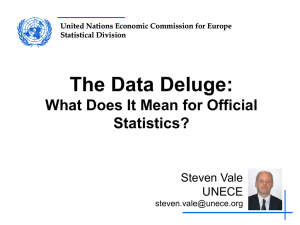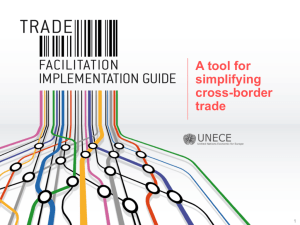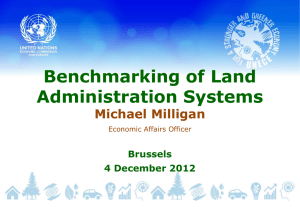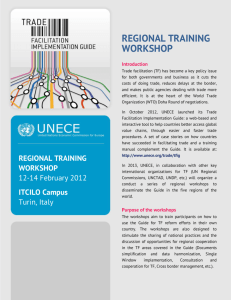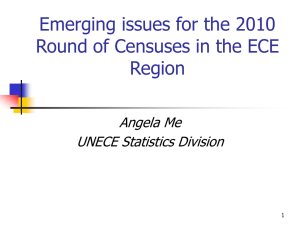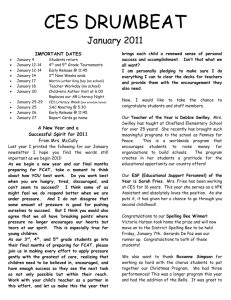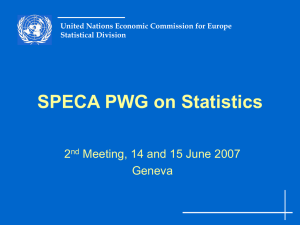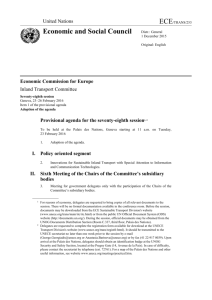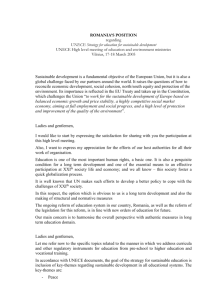PPT - United Nations Statistics Division
advertisement
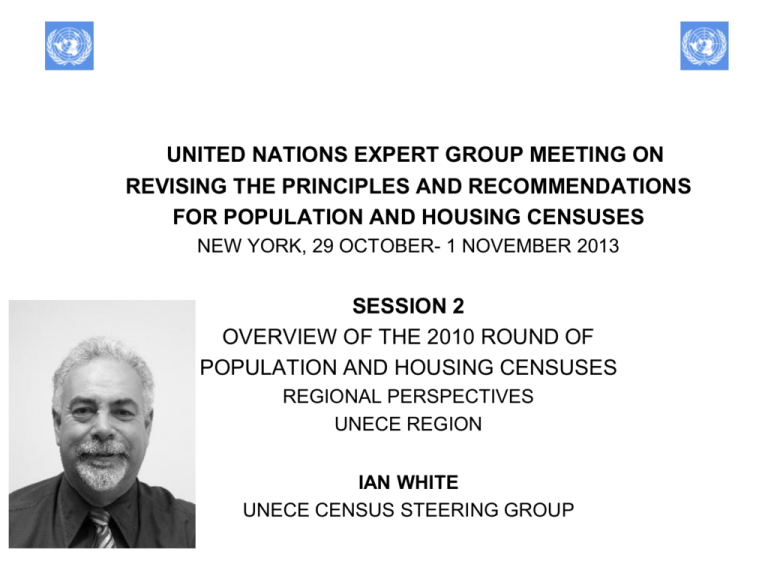
UNITED NATIONS EXPERT GROUP MEETING ON REVISING THE PRINCIPLES AND RECOMMENDATIONS FOR POPULATION AND HOUSING CENSUSES NEW YORK, 29 OCTOBER- 1 NOVEMBER 2013 SESSION 2 OVERVIEW OF THE 2010 ROUND OF POPULATION AND HOUSING CENSUSES REGIONAL PERSPECTIVES UNECE REGION IAN WHITE UNECE CENSUS STEERING GROUP PREPARATION OF CES RECOMMENDATIONS FOR THE 2020 ROUND • Conference of European Statisticians approved Work Plan in Paris in June 2012 • Task Force established and Terms of Reference agreed September 2012 • Online survey questionnaire developed SeptemberDecember 2012 • 24 Sections, more than 250 questions • Survey launched January 2013 (in SurveyMonkey format) • Response from 51 out of 57 countries • Results analysed by Task Forces February-May 2013 • Preparation of Task Force reports on 2010 practices and proposals for changes to the 2010 Recommendations June-September 2013 • Papers presented at joint UNECE/Eurostat Group of Experts meeting Geneva, 30 Sept-3 Oct 2013 UNECE TASK FORCES • Census methodology (Erich Schulte-Nordholt, Statistics Netherlands) • Census technology (Janusz Dygaszewicz, Central Statistics Office, Poland) • Quality and coverage (Peter Benton, Office for National Statistics, UK) • Costs and benefits (Alistair Calder, Office for National Statistics, UK) • Population bases and geographic characteristics - Population bases (Giampaolo Lanzieri, Eurostat) - Geographic characteristics (Harald Utne, Statistics Norway) • Demographic, household and family characteristics (Howard Hogan, US Census Bureau) • Economic and educational characteristics (Jari Nieminen, Statistics Finland) • Migration and ethno-cultural characteristics (Jane Badets, Statistics Canada) • Housing (Adelheid Bauer, Statistics Austria) OTHER TOPICS/ISSUES COVERED BY THE UNECE STEERING GROUP • Disability • Agriculture • Legislation • Field Operations • Communications and publicity • Security, confidentiality and disclosure control • Documentation, metadata and archiving • Innovations • Problems and successes UNECE Region Methodology in the UNECE Region Traditional census – 31 countries (36 in 2000) - Full field enumeration, no registers 20 - Full field enumeration supported by registers 10 - Full field enumeration plus annual sample survey 1 - Rolling census 1 Register based census – 9 countries (3 in 2000) - Only registers used 6 - Registers plus existing sample survey data 3 Combined methodology – 10 countries (6 in 2000) - Registers plus full field enumeration for selected topics 4 Registers plus sample field data for selected topics 5 Core topics in the UNECE Region • Place of usual residence • Locality • Sex • Age • Legal (de jure) marital status • Current activity status • Workplace • Occupation • Industry • Employment status • Educational attainment • Country/place of birth • Country of citizenship • Ever resided abroad • Year of arrival from abroad • Previous place of usual residence • Date of arrival from previous usual residence • Relationship between household members • Household status • Type of household • Size of household not asked in survey 82% 100% 100% 92% 96% 92% 96% 96% 98% 98% 98% 98% 75% 100% 86% 67% 98% 84% 96% not asked in survey Core topics in the UNECE Region • Family status • Type of family nucleus • Size of family nucleus • Tenure status (of household) • Housing arrangement • Type of living quarters • Location of living quarters • Occupancy status • Type of ownership • Number of occupants • Useful floor space/Number of rooms • Density standard • Water supply system • Toilet facilities • Bathing facilities • Type of heating • Type of building • Period of construction 86% 86% not asked in survey 94% 92% 92% 100% 86% 96% not asked in survey 84/92% 80/57% 78% 82% 86% 92% 86% 94% Non core topics in the UNECE Region • Urban/rural status • Location of place of education • Mode of transport to work/place of education • Distance travelled to work/place of education • Time taken to travel to work/place of education • De facto marital status • Children born alive • Date(s) of first/current marriage • Date(s) of first/current consensual union • Usual activity status • Unpaid/voluntary work • Type of sector (institutional unit) • Informal employment status • Type of place of work • Time usually worked • Time-related unemployment • Duration of unemployment • Size of workforce at workplace • Main source of livelihood • Income • Socio-economic group 92% 44% 45/33% 15/13% 29/25% 84% 69% 14/24% 2/12% 12% 6% 12% 4% 27% 29% 2% 18% 15% 42% 12% 27% Non core topics in the UNECE Region • Education qualifications • Field of study • School attendance • Literacy • Computer literacy • Country of previous usual residence • Total duration of residence in the country • 5-year migration • Reason for migration • Country of birth of parent(s) • Citizenship acquisition • Foreign background • Population relevant to international migration • Refugee background • Internally displaced persons • Ethnicity • Language • Religion • Disability status 33% 40% 69% 49% 18% 62% 20% 22% 37% 16% 14% not asked in survey not asked in survey not asked un survey not asked in survey 63% 71% 55% 67% Non core topics in the UNECE Region • Same-sex partnerships not asked in survey • Extended family status not asked in survey • Type of reconstituted family not asked in survey • Generational composition of household not asked in survey • Single or shared occupancy 43% • Rent 29% • Durable consumer goods 12% • Car availability 27% • Car parking 18% • Telephone/internet connection 29/43% • Own account agricultural production (household) 20% • Agricultural work 8% • Unoccupied dwellings 86% • Multi-occupancy 48% • Type of rooms 16% • Kitchen 52% • Cooking facilities 12% • Hot water 48% • Type of sewage disposal system 44% • Main type of energy for heating 58% Non core topics in the UNECE Region • Availability of electricity • Availability of piped gas • Air-conditioning • Position of dwelling in building • Accessibility to dwelling • Lift • Number of floors in building • Construction materials • State of repair 38% 38% 22% 30% 8% 24% 44% 36% 14% Summary of main proposals for possible changes to the CES Recommendations Methodology • More emphasis on the use of administrative registers and multi-modal approach to data collection • An closer examination of the benefits and disadvantages of the different methodologies Technology • More focus on GIS • Benefits of OCR/OMR to be re-assessed Cost and benefits • New chapter • Costs of different methodologies to be compared • The value of cost-benefit analysis to be stressed Documentation, metadata and archiving • The importance of keeping good records and an audit trail • The value of census records as a source of socio-historical data Summary of main proposals for possible changes to the CES Recommendations Quality and coverage •Consolidate separate sections of the 2010 Recommendations into a single chapter • Specific recommendations proposed: - Accuracy should be measured (by whatever method the country deems appropriate) - Accuracy measurements and methods should be published - Whatever method chosen should result in a comparable set of output-oriented quantitative indicators - An adjusted national total population estimate should be published - At the national level countries should aim to publish statistics that are accurate to within x% of the (unknown) true value - Not supported Outsourcing • The importance of good project management skills and knowledge of procurement to be stressed • The cheapest option is not always the best • Specific areas to be identified • More aligned with global recommendations, with particular emphasis on the need to: - protect confidentiality - gain public confidence - ensure data quality What about Big Data? Summary of main proposals for possible changes to the CES Recommendations Communication/Publicity • Still important for register-based censuses • Use of social media to be considered Population bases • A more detailed exposition of ‘usual residence’ Geographic characteristics • Urban/rural area to be a core (derived) topic • Degree of urbanization • Classification of place of work • New classification of mode of transport Demographic characteristics • De facto vs de jure marital status • Should de facto marital status be a core topic? • Should the use of a mixed classification of de jure and de facto marital status be discouraged explicitly? • Should ‘consensual union’ and ‘registered partnership’ be distinguished in the typology of family nuclei? • Should more focus be put on reconstituted families? • More focus on same sex unions be included as a non-core topic? Summary of main proposals for possible changes to the CES Recommendations Migration • More clearly distinguish topics related to international and internal migration • More clarity on the concept of year of arrival • Is there a case for promoting ‘country of previous residence abroad’ and ‘reason for migration’ to core status? • Recognition of value (but difficulty) of collecting information on ‘emigration’ • Consider ‘circular migration’ as a new topic Ethno-cultural characteristics • Importance of consultation community leaders and organisation to be stressed • Put ‘No religion’ response category first • Should ‘language’ be a core topic and should a classification be recommended? • Consider recommending the ‘Prefer not to answer’ approach to voluntary questions. Summary of main proposals for possible changes to the CES Recommendations Economic characteristics • Possible changes to ‘activity status’ classification • Possible changes to ‘employment status’ classification • Need to conform to any new ILO recommendations (such as the recognition of voluntary work as an activity status) • Difficulties with reconciling outputs from administrative and statistical data sources Housing • Treatment of ‘semi-independent’ housing as private or institutional • More focus on homelessness – but is this a housing or population base issue? • ‘Usable floor space’ vs ‘Number of rooms’ • Is a definition a room necessary? • Some core topics are no longer relevant (such as water supply and bathing facilities) • Proposal to modify ‘occupancy status’ and ‘type of building’ classifications • Focus of new ‘green’ topics such as use of solar or thermal energy Summary of main proposals for possible changes to the CES Recommendations Dissemination • 2010 Recommendations to be expanded to cover - Microdata - New media - Data visualisation - Value added products and mash-ups Timetable for the 2020 CES Recommendations • 1st Draft of 2020 Recommendations submitted to Steering Group February 2014 • 2nd Draft prepared by June 2014 to be discussed at UNECE/Eurostat meeting September 2014 • Final Draft by December 2014 to be discussed by CES Bureau February 2015 • Adoption by CES at June 2015 Plenary Session • Electronic version posted in July 2015 • Hard copy published end 2015 • Harmonization with global recommendations important • Impact on 2020 EU Census legislation Timetable for the 2020 CES Recommendations • 1st Draft of 2020 Recommendations submitted to Steering Group February 2014 • 2nd Draft prepared by June 2014 to be discussed at UNECE/Eurostat meeting September 2014 • Final Draft by December 2014 to be discussed by CES Bureau February 2015 • Adoption by CES at June 2015 Plenary Session • Electronic version posted in July 2015 • Hard copy published end 2015 • Harmonization with global recommendations important • Impact on 2020 EU Census legislation THANK YOU
